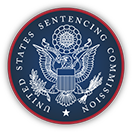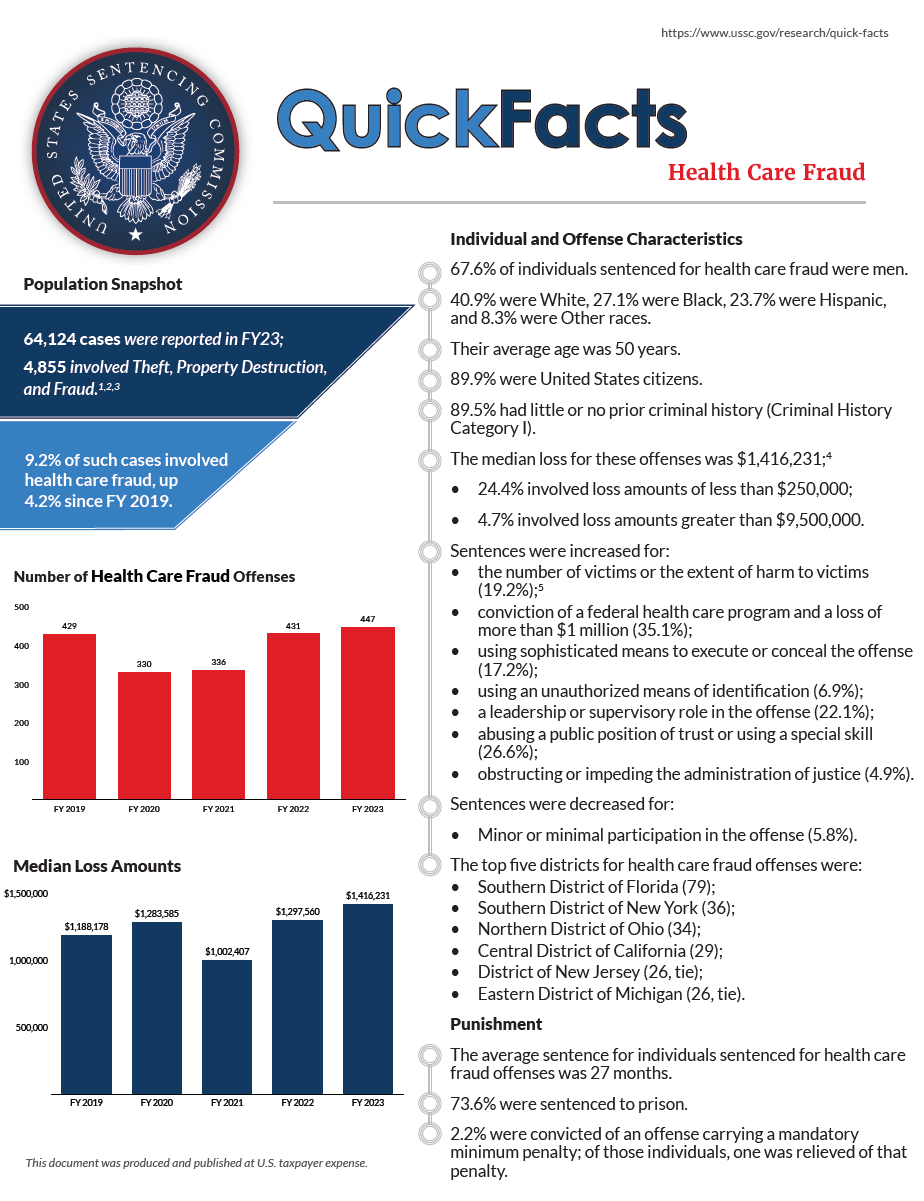Of the 61,678 cases reported to the Commission in fiscal year 2024, 395 involved health care fraud.1,2 Health care fraud offenses have increased 19.7% since fiscal year 2020.
Click the cover for the PDF handout or learn more below.
Individual and Offense Characteristics
- 67.8% of individuals sentenced for health care fraud were men.
- 55.0% were White, 19.2% were Hispanic, 15.4% were Black, and 10.4% were Other races.
- Their average age was 50 years.
- 93.7% were United States citizens.
- 90.4% had little or no prior criminal history (Criminal History Category I).
- The median loss for these offenses was $2,532,314;3
- 18.2% involved loss amounts of less than $250,000;
- 19.8% involved loss amounts greater than $9,500,000.
- Sentences were increased for:
- the number of victims or the extent of harm to victims (12.4%);4
- conviction of a federal health care offense and a loss of more than $1 million (42.5%);
- using sophisticated means to execute or conceal the offense (21.3%);
- using an unauthorized means of identification (7.6%);
- a leadership or supervisory role in the offense (24.8%);
- abusing a public position of trust or using a special skill (29.1%);
- obstructing or impeding the administration of justice (4.1%).
- Sentences were decreased for:
- minor or minimal participation in the offense (4.3%).
- minor or minimal participation in the offense (4.3%).
- The top five districts for individuals sentenced for health care fraud offenses were:
- Southern District of Florida (65);
- District of New Jersey (31);
- Southern District of New York (26);
- Eastern District of New York (17);
- Southern District of Texas (17).
Punishment
- The average sentence for individuals sentenced for health care fraud was 27 months.
- 74.7% were sentenced to prison.
- 2.8% were convicted of an offense carrying a mandatory minimum penalty; 54.5% of those individuals were relieved of that penalty.
Sentences Relative to the Guideline Range
- 57.0% of sentences for health care fraud were under the Guidelines Manual:
- 18.0% were within the guideline range.
- 35.4% were substantial assistance departures.
- The average sentence reduction was 69.6%.
- The average sentence reduction was 69.6%.
- 0.5% were Early Disposition Program (EDP) departures.5,6
- 2.8% were some other downward departure.
- The average sentence reduction was 74.1%.
- The average sentence reduction was 74.1%.
- 0.3% were upward departures.
- 18.0% were within the guideline range.
- 43.0% of sentences for health care fraud were variances.
- 42.8% were downward variances.
- The average sentence reduction was 56.4%.
- The average sentence reduction was 56.4%.
- 0.3% were upward variances.
- 42.8% were downward variances.
- The average guideline minimum has fluctuated and average sentence imposed has remained steady over the past five years.
- The average guideline minimum increased and decreased throughout the fiscal years. The average guideline minimum was 51 months in fiscal year 2020 and 50 months in fiscal year 2024.
- The average sentence was 30 months in fiscal year 2020 and 27 months in fiscal year 2024.
- The average guideline minimum increased and decreased throughout the fiscal years. The average guideline minimum was 51 months in fiscal year 2020 and 50 months in fiscal year 2024.
1 Health care fraud includes cases in which the individual was sentenced under §2B1.1 (Larceny, Embezzlement, and Other Forms of Theft; Offenses Involving Stolen Property; Property Damage or Destruction; Fraud and Deceit; Forgery; Offenses Involving Altered or Counterfeit Instruments Other than Counterfeit Bearer Obligations of the United States) using a Guidelines Manual in effect on November 1, 2001 or later and where the offense conduct as described in the Presentence Report involved the defrauding of a government or private health care entity.
2 Cases with incomplete sentencing information were excluded from the analysis.
3 The Loss Table was amended effective November 1, 2001 and November 1, 2015.
4 The Victims Table and Sophisticated Means adjustment were amended effective November 1, 2015.
5 “Early Disposition Program” (or EDP) departures are departures where the government sought a sentence below the guideline range because the defendant participated in the government’s Early Disposition Program, through which cases are resolved in an expedited manner. See USSG §5K3.1.
6 The Commission does not report the average for categories with fewer than three cases.
SOURCE: United States Sentencing Commission, FY 2020 through FY 2024 Datafiles, USSCFY20-USSCFY24.

